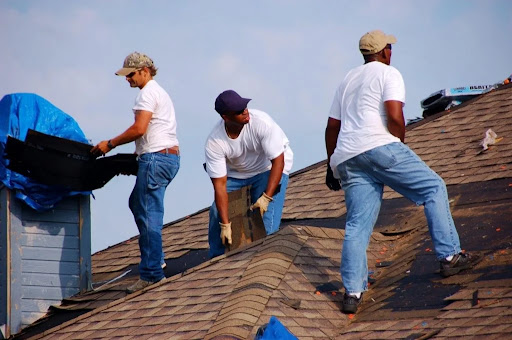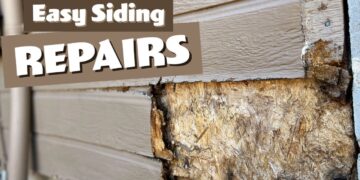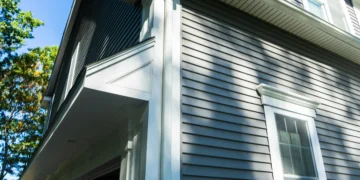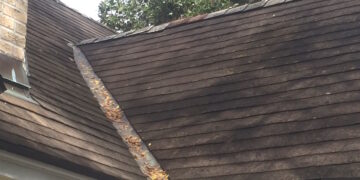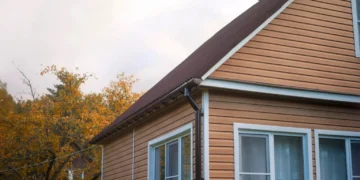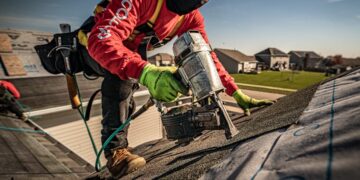As we delve into the world of roofing siding repair, we uncover the critical importance of this maintenance task in preserving the structural soundness of any building. From preventing costly damages to ensuring long-lasting durability, the journey of roofing siding repair is one filled with insights and valuable tips.
Exploring the common types of damage, essential inspection steps, necessary materials and tools, and the eternal debate of DIY versus professional repairs, this comprehensive guide equips you with the knowledge needed to navigate the realm of roofing siding repair efficiently.
Importance of Roofing Siding Repair
Roofing siding repair plays a crucial role in maintaining the integrity of a building. It serves as the first line of defense against harsh weather conditions, moisture, and other external elements that can cause damage to the structure.
Preventing Further Damage with Timely Repairs
Timely repairs to roofing siding can prevent further damage to the building. Small issues such as cracks or missing shingles, if left unattended, can escalate into larger problems that may compromise the structural stability of the property.
Costly Consequences of Neglecting Repair
- Water Damage: Leaks in the roofing siding can allow water to seep into the interior of the building, leading to water damage, mold growth, and rot.
- Energy Inefficiency: Damaged roofing siding can result in poor insulation, causing energy bills to increase as the HVAC system works harder to maintain a comfortable temperature.
- Decreased Property Value: Neglected roofing siding can detract from the curb appeal of a property, reducing its overall value in the real estate market.
Common Types of Roofing Siding Damage
Roofing siding can be subjected to various types of damage due to different factors. It is essential to understand these types of damage to address them promptly and prevent further issues.
1. Cracks
Cracks in roofing siding can occur due to various reasons such as extreme weather conditions, age, or poor installation.
- Visible signs: Visible cracks on the surface of the siding, moisture seepage, and discoloration.
2. Rotting
Rotting of roofing siding is often caused by prolonged exposure to moisture, leading to decay of the material.
- Visible signs: Soft or spongy areas on the siding, mold or mildew growth, and a musty odor.
3. Warping
Warping of siding can occur due to excessive heat exposure, improper installation, or moisture infiltration.
- Visible signs: Buckling or bending of the siding, gaps between the siding panels, and uneven appearance.
4. Fading
Fading of roofing siding is usually a result of prolonged exposure to UV rays and harsh weather conditions.
- Visible signs: Loss of color intensity, uneven fading across the siding surface, and a dull appearance.
Steps for Inspecting Roofing Siding
Regular inspections of roofing siding are crucial in maintaining the integrity of your home and preventing costly repairs down the line. By following a comprehensive guide on how to inspect roofing siding for damage, you can identify issues early on and address them promptly.
Importance of Regular Inspections
- Prevent extensive damage: Regular inspections help catch small issues before they escalate into major problems, saving you time and money in the long run.
- Ensure safety: Damaged roofing siding can pose safety risks to you and your family, so regular inspections are essential for maintaining a secure living environment.
- Prolong lifespan: By detecting and fixing damage early, you can extend the lifespan of your roofing siding and avoid the need for premature replacement.
Tips for Roofing Siding Inspection
- Check for signs of water damage, such as mold, mildew, or discoloration, which could indicate leaks.
- Inspect the siding for cracks, chips, or gaps that may allow moisture to seep in and cause further damage.
- Look for signs of pest infestation, such as holes or gnaw marks, which can weaken the siding and compromise its integrity.
- Examine the paint or finish for peeling, fading, or blistering, as these can be indicators of weathering and damage.
- Ensure that the siding is properly attached and secure, as loose or missing pieces can leave your home vulnerable to the elements.
Materials and Tools Needed for Roofing Siding Repair
When it comes to repairing roofing siding, having the right materials and tools is essential to ensure a successful and long-lasting repair. Using high-quality materials and the correct tools can make a significant difference in the outcome of the repair.
Essential Materials for Roofing Siding Repair
- Siding panels or shingles
- Flashing
- Caulk or sealant
- Nails or screws
- Primer and paint (if needed)
Specific Tools for Different Types of Repairs
- Hammer or nail gun
- Screwdriver
- Siding removal tool
- Caulking gun
- Level
- Tape measure
Using the right tools for the job can make the repair process easier and more efficient
.
Importance of Using High-Quality Materials
- High-quality materials are more durable and resistant to weather elements.
- They provide better insulation and protection for your home.
- Using inferior materials can result in frequent repairs and higher maintenance costs in the long run.
DIY vs. Professional Roofing Siding Repair
When it comes to roofing siding repair, homeowners often face the decision of whether to tackle the repairs themselves or hire a professional. Each option has its own set of advantages and disadvantages, and knowing when to choose one over the other can save both time and money in the long run.
Advantages and Disadvantages of DIY Repairs
- Advantages:
- Cost-effective as you save on labor fees.
- You have control over the repair process.
- Allows for a sense of accomplishment.
- Disadvantages:
- May lack the necessary skills and experience.
- Could lead to further damage if not done correctly.
- Can be time-consuming and physically demanding.
When to Attempt DIY Repairs and When to Hire Professionals
- DIY Repairs:
- For minor damages like small cracks or loose siding.
- If you have experience with similar repairs and feel confident in your abilities.
- When you have the time and resources to dedicate to the repair project.
- Hiring Professionals:
- For extensive damage that requires specialized equipment or skills.
- When safety is a concern, such as working at heights or handling hazardous materials.
- If you lack the time or physical ability to complete the repairs on your own.
Choosing the Right Approach Based on the Extent of Damage
- Assess the severity of the damage before deciding on DIY or professional repair.
- Consider your own skills and comfort level with the repair process.
- If in doubt, consult with a professional for an assessment and recommendation.
Safety Measures During Roofing Siding Repair
When working on roofing siding repairs, it is crucial to prioritize safety to prevent accidents and injuries. This includes taking necessary precautions and using appropriate personal protective equipment (PPE) to ensure a safe working environment.
Using Personal Protective Equipment
- Wear a hard hat to protect your head from falling debris or objects.
- Use safety goggles to shield your eyes from dust, debris, and potential hazards.
- Wear gloves to protect your hands from sharp materials and chemicals.
- Use a respirator mask to prevent inhaling harmful particles or fumes.
- Wear sturdy work boots with good traction to prevent slipping or falling.
Working at Heights Safely
- Ensure that your ladder is stable and secure before climbing up to elevated sections.
- Use a safety harness and tie-off system when working on steep roofs to prevent falls.
- Avoid working on wet or slippery surfaces to reduce the risk of accidents.
- Stay aware of your surroundings and be cautious of potential hazards while working at heights.
Epilogue
In conclusion, roofing siding repair stands as a cornerstone in the upkeep of any structure, offering a shield against potential hazards and maintaining the aesthetic appeal of your property. By staying vigilant, employing the right tools and materials, and knowing when to seek professional assistance, you can ensure that your roofing siding remains in optimal condition for years to come.
FAQ Insights
What are the common causes of roofing siding damage?
Roofing siding damage can be caused by factors such as severe weather conditions, lack of maintenance, pest infestations, and aging materials.
Is it necessary to inspect roofing siding regularly?
Regular inspections are crucial to catch any damage early on and prevent it from escalating into more extensive issues.
How can I ensure my safety during roofing siding repairs?
Always use appropriate personal protective equipment, follow safety guidelines, and consider hiring professionals for risky repairs.

